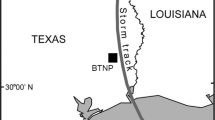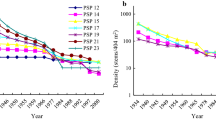Abstract
Frequent intermediate disturbances can produce qualitatively different spatial heterogeneity and environmental variability than large infrequent disturbances, which facilitates the coexistence of disparate species types. We hypothesized that species coexistence will be maximized at sites exposed to recurring hurricanes with intermediate frequencies and effects. Consequently, we sought to determine if exposure vulnerability (EV) from three hurricanes with intermediate effects and frequencies (Ivan-2004, Dennis-2005 and Dean-2007), or the interaction between exposure and topography, could be used to explain forest structural dynamics and composition. We used data obtained in 2006 and 2012 from within 45, 25 × 25 m (2.8125 ha) permanent sample plots, established according to a randomized block design, and stratified according to elevation and aspect/sites (NE and SW facing ridges) in a tropical montane wet forest, John Crow Mountains, Jamaica. There was a significant reduction in basal area (BA) (14%), tree volume (10%), and density (26%) and there was a negative shift in the height profile of trees. Understory light (2008), stem density, and mortality increased with EV but decreased with aspect. The NE aspect/sites had higher EV after Dean and the other hurricanes. Consequently, BA, volume and density increased significantly for light-demanding species at the NE sites, but declined significantly overall with minimal changes at SW sites. Moreover, diversity was significantly higher at sites with higher EV for the three hurricanes. The frequent hurricanes with intermediate effects may have therefore maintained/increased spatial heterogeneity, which promoted the coexistence of species with disparate life histories at more exposed sites.





Similar content being viewed by others
References
Bartoń K. 2015. MuMIn: Multi-Model Inference. R package version 1.13.4. http://CRAN.R-project.org/package=MuMIn.
Batke SP, Jocque M, Kelly DL. 2014. Modelling hurricane exposure and wind speed on a mesoclimate scale: a case study from Cusuco NP, Honduras. PLoS One 9:e91306.
Bates D, Maechler M, Bolker B, Walker S. (2014). lme4: Linear mixed-effects models using Eigen and S4. R package version 1.1-7, http://CRAN.R-project.org/package=lme4.
Bellingham P, Tanner E. 2000. The influence of topography on tree growth, mortality and recruitment in a tropical montane forest. Biotropica 32:378–84.
Bellingham P, Tanner E, Healey J. 1995. Damage and responsiveness of Jamaican montane tree species after disturbance by a hurricane. Ecology 76:2562–80.
Bender MA, Knutson TR, Tuleya RE, Sirutis JJ, Vecchi GA, Garner ST, Held IM. 2011. Modeled impact of anthropogenic warming on the frequency of intense Atlantic hurricanes. Science 327:454–8.
Bjornstad ON. 2013. ncf: Spatial Nonparametric Covariance Functions. R package version 1.1-5. http://CRAN.R-project.org/package=ncf.
Boose ER, Foster DR, Fluet M. 1994. Hurricane impacts to tropical and temperate forest landscapes. Ecol Monogr 64:370–400.
Boose E, Serrano M, Foster D. 2004. Landscape and regional impacts of hurricanes in Puerto Rico. Ecol Monogr 74(2):335–52.
Brokaw N, Grear J. 1991. Forest structure before and after Hurricane Hugo at three elevations in Luquillo Mountains, Puerto Rico. Biotropica 23:386–92.
Brokaw N, Walker L. 1991. Summary of the effects of Caribbean hurricanes on vegetation. Biotropica 23:442–7.
Canham CD, Thompson J, Zimmerman JK, Uriarte M. 2010. Variation in susceptibility to hurricane damage as a function of storm severity in Puerto Rican tree species. Biotropica 42:87–94.
Chai S, Tanner E. 2011. 150-year legacy of land use on tree species composition in old-secondary forests of Jamaica. J Ecol 99:113–21.
Clarke KR, Gorley RN. 2001. PRIMER Version 6 User Manual/Tutorial. Plymouth: Primer-E.
Connell JH. 1978. Diversity in tropical rain forests and coral reefs. Science 199:1302–10.
Gannon B, Martin P. 2014. Reconstructing hurricane disturbance in a tropical montane forest landscape in the Cordillera Central, Dominican Republic: implications for vegetation patterns and dynamics. Arctic Antarctic Alpine Res 46:767–76.
Gray KM, Symes GA. 1972. Forestry development and watershed management in the upland regions, Jamaica—Forest inventory of Jamaica. Kingston: UNDP/FAO Technical Report 3. 175p.
Heartsill-Scalley T, Scatena F, Lugo A, Moya S, Estrada Ruiz C. 2010. Changes in structure, composition and nutrients during 15 years of hurricane-induced succession in a subtropical wet forest in Puerto Rico. Biotropica 42:455–63.
Kelly D. 1986. Native forests on wet limestone in North-Eastern Jamaica. In: Thompson DA, Bretting PK, Humphreys M, Eds. Forests of Jamaica. Jamaica: The Jamaican Society of Scientists and Technologists. pp 31–42.
Knutson TR, McBride JL, Johnny Chan J, Emanuel K, Holland G, Landsea C, Held I, Kossin JP, Srivastava AK, Sugi M. 2010. Tropical cyclones and climate change. Nat Geosci 3:157–63.
Kuznetsova A, Brockhoff PB, Christensen RHB. 2015. lmerTest: tests in linear mixed effects models. R package version 2.0-25.
Lafrankie J, Ashton P, Chuyong G, Co L, Condit R, Davies S, Villa G. 2006. Contrasting structure and composition of the understory in species-rich tropical rain forests. Ecology 87:2298–305.
Losos EC, Leigh EG Jr. 2004. Tropical forest diversity and dynamism: findings from a large scale-plot network. Chicago: University of Chicago Press. p 645.
Luke D, McLaren K, Wilson B. 2014. The effects of a hurricane on seedling dynamics and abiotic interactions in a tropical lower montane wet forest. J Trop Ecol 30:55–66.
Luke D, McLaren K, Wilson BS. 2016. Short-term dynamics and the effects of biotic and abiotic factors on plant physiognomic groups in a hurricane-impacted lower montane tropical forest. Biotropica 48:332–41. doi:10.1111/btp.12288.
Martin PH, Sherman RE, Fahey TJ. 2007. Tropical montane forest ecotones: climate gradients, natural disturbance, and vegetation zonation in the Cordillera Central, Dominican Republic. J Biogeogr 34:1792–806.
Martin PH, Fahey TJ, Sherman RE. 2010. Vegetation zonation in a neotropical montane forest: environment, disturbance, and ecotones. Biotropica 43:533–43.
Nakagawa S, Schielzeth H. 2013. A general and simple method for obtaining R2 from generalized linear mixed-effects models. Methods Ecol Evolut 4:133–42.
Oksanen J, Blanchet FG, Roeland Kindt R, Legendre P, Minchin PR, O’Hara RB, Simpson GL, Solymos P, Henry M, Stevens H, Wagner H. 2013. vegan: Community Ecology Package. R package version 2.0-10. http://CRAN.R-project.org/package=vegan.
Ostertag R, Inman-Narahari F, Cordell S, Giardina C, Sack L. 2014. Forest structure in low-diversity tropical forest: a study of Hawaiin wet and dry forests. PloS One 9:e103268.
Planning Institute of Jamaica (PIOJ). 2007. Assessment of the socio-economic and environmental impact of Hurricane Dean on Jamaica. http://www.pioj.gov.jm/Portals/0/Sustainable_Development/HurricaneDean.pdf.. Accessed Feb 12 2016.
R Core Team. 2014. R: A Language and Environment for Statistical Computing. R Foundation for Statistical Computing, Vienna. http://www.R-project.org/.
Reilly A. 1991. The effects of Hurricane Hugo in three tropical forests in the U.S. Virgin Islands. Biotropica 23:414–19.
Roxburgh SH, Shea K, Wilson JB. 2004. The intermediate disturbance hypothesis: patch dynamics and mechanisms of species coexistence. Ecology 85:359–71.
Romme W, Everham E, Frelich L, Moritz M, Sparks R. 1998. Are large, infrequent disturbances qualitatively different from small frequent disturbances? Ecosystems 1:524–34.
Šebková B, Šamonil P, Janík D, Adam D, Král K, Vrška T, Unar P. 2011. Spatial and volume patterns of an unmanaged submontane mixed forest in Central Europe: 160 years of spontaneous dynamics. For Ecol Manag 262:873–85.
Shea K, Roxburgh SH, Rauschert ESJ. 2004. Moving from pattern to process: coexistence mechanisms under intermediate disturbance regimes. Ecol Lett 7:491–508. doi:10.1111/j.1461-0248.2004.00600.x.
Sheil D. 1999. Tropical forest diversity, environmental change and species augmentation: after the intermediate disturbance hypothesis. J Veg Sci 10:851–60.
Sheil D, Burslem DFRP. 2013. Defining and defending Connell’s intermediate disturbance hypothesis: a response to Fox. Trends Ecol Evolut 28:571–2.
Stueve K, Perry C, Nelson M, Healey S, Hill A, Moisen G, Cohen W, Gormanson D, Huang C. 2011. Ecological importance of intermediate windstorms rival large infrequent disturbances in the northern Great Lakes. Ecosphere 2:2.
Tanner EVJ, Bellingham PJ. 2006. Less diverse forest is more resistant to hurricane disturbance: evidence from montane rain forests in Jamaica. J Ecol 94:1003–10.
Turner M, Baker W, Peterson C, Peet R. 1998. Factors influencing succession: lessons from large infrequent natural disturbances. Ecosystems 1:511–23.
Wood SN. 2004. Stable and efficient multiple smoothing parameter estimation for generalized additive models. J Am Stat Assoc 99:673–86.
Wood SN. 2006. Generalized additive models: an introduction with R. New York: Chapman and Hall/CRC.
Zimmerman J, Everham EIII, Waide R, Lodge D, Taylor C, Brokaw N. 1994. Responses of tree species to hurricane winds in subtropical wet forest in Puerto Rico: implications for tropical tree life histories. J Ecol 82:911–22.
Zuur A, Ieno EN, Walker N, Saveliev AA, Smith GM. 2009. Mixed effects models and extensions in ecology with R. Heidelberg: Springer Science+Business Media.
Acknowledgements
We wish to thank the Rufford Foundation, the International Foundation for Science, the Wildlife Conservation Society and The Environmental Foundation of Jamaica for providing financial assistance for plot establishment and the 2006 assessments. The Jamaica Protected Area Trust (Forest Conservation Fund) provided financial assistance for the 2012 assessments. We would also like to also thank our field assistant Mr. Kirk Lewis and our other field guides who assisted with plot establishment.
Author information
Authors and Affiliations
Corresponding author
Additional information
Author contributions D.L. preformed the research and analyzed the data and wrote the paper. K.M. conceived of and designed the study, secured funding (PI), provided supervision, assisted with data interpretation, developed the EV method and generated the EV maps, checked DL’s analyses for spatial autocorrelation and reviewed and edited the manuscript. B.W. helped to secure funding (Co-PI) and also edited the manuscript.
Electronic supplementary material
Below is the link to the electronic supplementary material.
Rights and permissions
About this article
Cite this article
Luke, D., McLaren, K. & Wilson, B. Modeling Hurricane Exposure in a Caribbean Lower Montane Tropical Wet Forest: The Effects of Frequent, Intermediate Disturbances and Topography on Forest Structural Dynamics and Composition. Ecosystems 19, 1178–1195 (2016). https://doi.org/10.1007/s10021-016-9993-y
Received:
Accepted:
Published:
Issue Date:
DOI: https://doi.org/10.1007/s10021-016-9993-y




